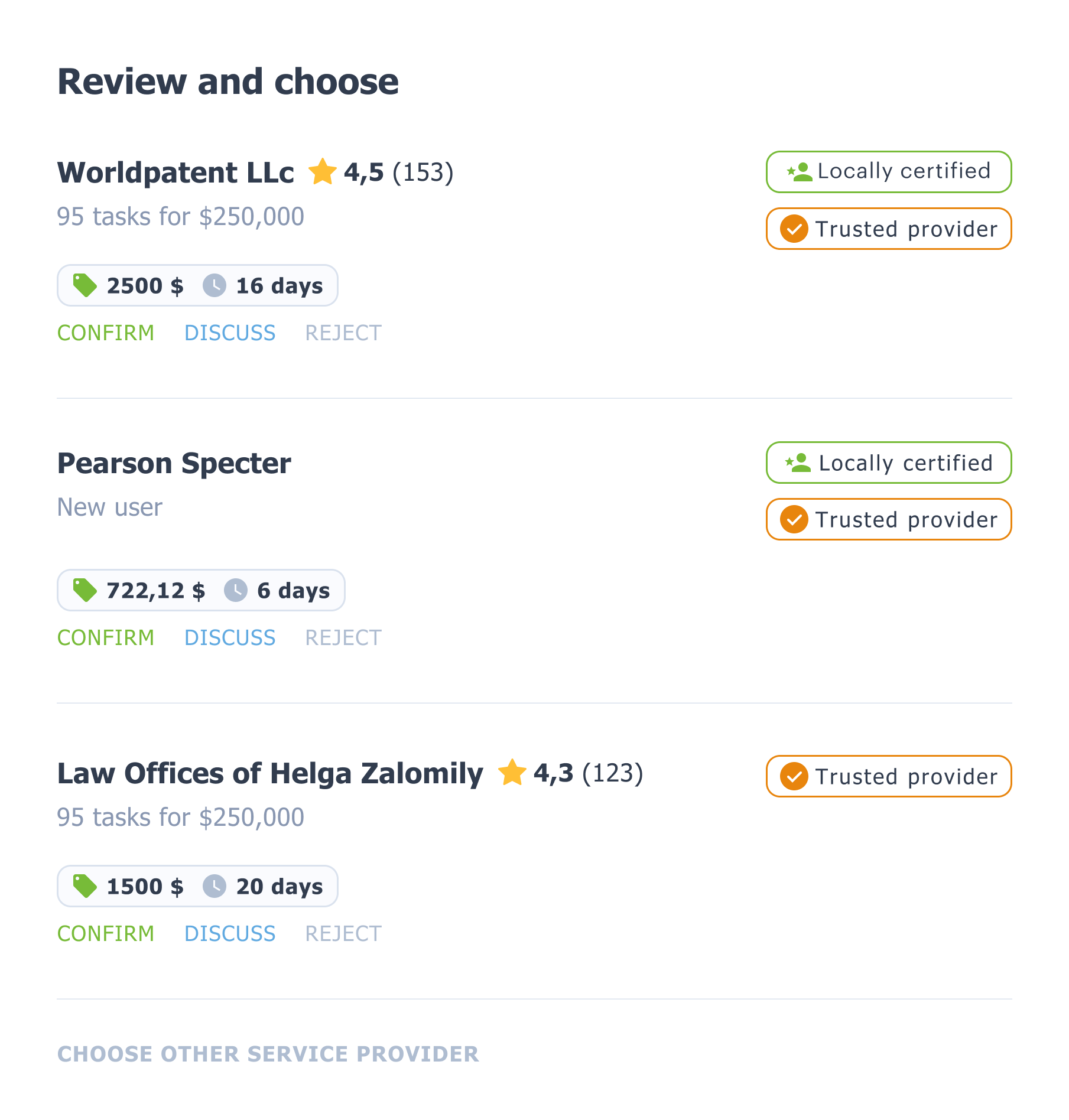Filing a Patent Application in Malaysia
This stage involves the formulation of a comprehensive description and illustrations depicting your invention. It also includes crafting of claims, ensuring your patent provides the maximum possible protection.



This stage involves the formulation of a comprehensive description and illustrations depicting your invention. It also includes crafting of claims, ensuring your patent provides the maximum possible protection.







-
An AI-powered IP assistant that helps you create a detailed assignment within minutes.
-
Selection of the most suitable local patent attorney based on specific criteria.
-
Drafting a brief description, filing the application, and handling government fees.
-
Online monitoring and reporting on the platform throughout the entire process.

-

More than 800 IP law firms from 150+ countries, ranking and reviews
-

An AI-powered IP assistant that helps create tasks and find relevant attorneys
-

Flat fees, secure and fast online payments with guaranteed results
-

24/7 access to the registration process and online data storage for all your cases









































Filing a Patent Application in Malaysia: Key Steps and Insights
Submitting a patent application is a crucial step for innovators aiming to protect their technological solutions and secure exclusive rights. This process grants the inventor control over the commercial use of their invention within the country. A proper submission strategy can also form the foundation for protection in other jurisdictions via international agreements.
Exclusive rights are governed by the Patents Act 1983 and the accompanying Regulations. The law provides coverage for inventions that are novel, involve an inventive step, and are capable of industrial application. Understanding how to navigate the intellectual property system allows individuals and businesses to maximize the value of their innovations.
Understanding Patent Application Options
When considering protection, applicants may choose between two main types of submissions:
- Provisional filing: This type of submission allows inventors to secure an early date without submitting full claims. It offers 12 months of priority and is useful when the invention is still being developed.
- Complete specification: This must include a full description, claims, abstract, and drawings (if needed). It undergoes formal and substantive examination before a decision on grant is made.
A temporary version is often file first to secure the date, followed by the complete set of documents within the allowed time frame.
Steps to File a Patent in Malaysia
Protecting an invention involves a structured process managed by the Intellectual Property Corporation of Malaysia (MyIPO). Below is an outline of the key stages:
1. Prepare the submission
Start by drafting a detailed description, technical drawings, claims, and abstract.
2. Choose the type of request
Decide whether to begin with a preliminary or full document set.
3. Submit the documents
Applicants can file their request either manually or online via the MyIPO system.
4. Pay the official fees
The initial cost varies depending on the type of request and whether it’s done by an individual or company.
5. Formal examination
The office checks for compliance with administrative requirements.
6. Publication
At 18 months from the earliest date, the content becomes publicly available.
7. Request for detailed review
Must be made within 18 months from the full specification’s submission.
8. Examination and grant
The examiner evaluates novelty, inventive step, and practical applicability. If all criteria are met, protection is granted.
Timeline and Duration of Patent Protection
After successful filing and approval, protection is granted for up to 20 years from the date of request, subject to annual renewal fees. Timely maintenance is essential to keep rights in force. Missing deadlines could result in irrevocable loss of exclusivity.
Benefits of Filing a Patent in Malaysia
The growing economy and focus on innovation make it an attractive location for securing intellectual property rights. Benefits of protecting an invention here include:
- Exclusive rights to commercialize within Malaysia
- Legal grounds to prevent unauthorized use
- Potential revenue through licensing or sale
- Foundation for global protection under the Paris Convention or PCT
By securing legal ownership, inventors enhance their market value and competitive position.
Considerations Before Submitting an Application
Applicants should conduct a prior art search before initiating the process to assess novelty. It’s also recommended to consult a legal advisor or IP agent for technical drafting, especially in complex cases. Poorly worded claims or missing disclosures can result in rejection or limited enforceability.
In addition, consider the following:
- The invention must be new and not publicly disclosed
- It should involve a non-obvious technical solution
- The output must be applicable in an industry setting
- Subject matter excluded from protection includes scientific theories, business methods, and diagnostic methods for humans or animals
Using a Patent Service for Professional Support
While individuals can complete the process independently, many opt for assistance from a registered service provider. Professional help ensures accurate documentation, timely responses to office actions, and improved chances of success. This is especially important when filing under international agreements or for high-value inventions.
Summary: Strategic Patent Filing in Malaysia
Completing a patent application is both a legal and strategic move. From choosing between a provisional or complete version to managing examination requests, inventors must follow a defined procedure. Despite initial challenges, securing rights in a key market like Malaysia can lead to long-term advantages in technology-driven industries.
With the proper approach—starting from a solid draft, adhering to deadlines, and seeking guidance from a qualified lawyer or agent—innovators can achieve successful outcomes and protect their work effectively for years to come.




